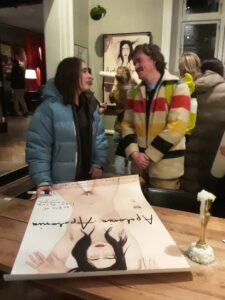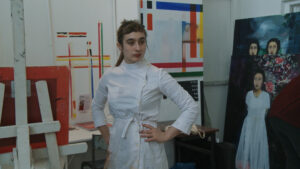— SHORTLISTED FOR AN OSCAR NOMINATION FOR BEST DOCUMENTARY —
(Translated/revised from Danish for the occasion for an international audience.)
(The slightly different Danish version: https://www.lingoblog.dk/apolonia-13-en-kvindes-rejse-til-maanen-og-tilbage/)
It took 13 years to make the film. Lea Glob, a former student at Aarhus Cathedral School, Denmark, trained as a documentary filmmaker, decided in 2009 to make a film about a young woman, Apolonia Sokol, living in Paris. They became friends and no matter where they are, they keep in touch. Lea is fairly stable in Denmark, while Apolonia moves from one place to another. Lea has been able to film Apolonia everywhere and always. After all, Apolonia was used to being filmed. Her parents filmed their intercourse where she was conceived, adding a verbal message to their future child. They also filmed the mother’s belly while parents talked to both the fetus and their future adult child. And they filmed her birth. The child would be allowed to see their recordings when she turned 18. And that was before everyone had a camera in their phone. Boxes full of video tapes. Bodies and nudity continue to play a role in the film, including a self-portrait on the film poster and on the soundtrack LP.

Apolonia was born in France and she grew up in both Denmark and France. Her youth was rather unusual. Her mother grew up in Poland, but the family was originally from Belarus, with a detour via a camp in Siberia. Apolonia’s mother decided at one point to go to Paris to try her luck there. She then found it in the form of a French dramatist. Apolonia’s father produced theater in Paris, and together they built a theater in their house. It was an activist bohemian theater in the heart of Paris. Apolonia actually lived in the theater for the first eight years of her life, with her parents. When she was eight, her parents divorced, and Apolonia contracted a fatal disease with a life expectancy of a maximum of 10 years. But she survived. After the divorce, the mother moved with Apolonia to Denmark, but Apolonia went back to Paris as soon as she turned 18, where she moved into the theater again to be educated as a painter. She is admitted to the prestigious École des Beaux Arts in Paris.

The theater has also at one time provided shelter to the well-known anti-dictatorial feminist movement FEMEN from Ukraine – which was then against a dictatorship. They used their naked women’s bodies as weapons against oppression and for women’s rights. The group’s members had to flee the repressive regime around 2012 and they arrived in Paris – some with both arms broken under torture. They got a place in the theater. What actually became of them? And what about the woman with two arms in plaster? You can see that in the film.

The film is about Apolonia as a female artist, her quest for fame, and not least the daily worries. How do I get money for food? How can I become one of the best of my cohort so that I can have a year to prepare for the biggest art exhibition of young French artists? Should I accept the invitation to have a cup of tea with Harvey Weinstein (the world did not know about his sex crimes at this time)? Should I change my painting style or my topics? Should I create what I want or what others want? Should I go to the USA because I can get a studio there? Should I collaborate with the man described in the newspapers as “the Satan of the art trade”? Do I go back to Denmark? Should I have children? Can I do ten paintings within a month? Or do you become a lunatic (luna = moon)?
I’m not revealing anything. You have to watch the film yourself and get the answers to these questions. The film also passes the Bechdel test with flying colors. That is, a film where a woman talks to another woman, without it being about men. After all, almost all films only show women as objects of romantic interest for men, or as counterparts for men. That is not the case here.
Maybe you feel like smoking a cigarette or drinking a glass of red wine. Would a movie about YOU, filmed over 13 years, be as fascinating as this one? Watch the movie for yourself and find out.
But of course I must also say something about language before I forget it. It is, after all, Lingoblog.dk – Denmark’s largest blog about language and linguistics.
We can hear Apolonia speak four languages in the film: Danish (with her mother and Lea), French (with her father), Polish (with her grandmother and family in Poland), English (with some art dealers and vultures), maybe also Russian/Belarusian (I couldn’t hear it), in one of the first scenes. Apolonia thus grew up with three or four languages, apparently all fluent. She was, from a linguistic point of view, a lucky person with so many languages. Whether she was also that in art, you as a viewer must judge for yourself.

Now the film is shortlisted for an Oscar nomination, it is said. In the company of people who saw the film in the pre-premiere, we all agreed that it was one of the best, for most of us the very best, of documentaries we have ever seen.
Peter Bakker once drew himself as a cameraman when at school he could draw what he wanted to be when he grew up. This dream burst. He became a linguist at Aarhus University. In addition, he occasionally writes language-related film reviews for Lingoblog.dk and columns about the university world at Omnibus.au.dk. His father was a technical draftsman, his eldest daughter is a visual artist. Sometimes talent skips a generation.
Edited February 13th 2024, 08.14.








2 thoughts on “Apolonia 13. A woman’s journey to the moon and back. From theater to painter. A moving documentary worth watching”